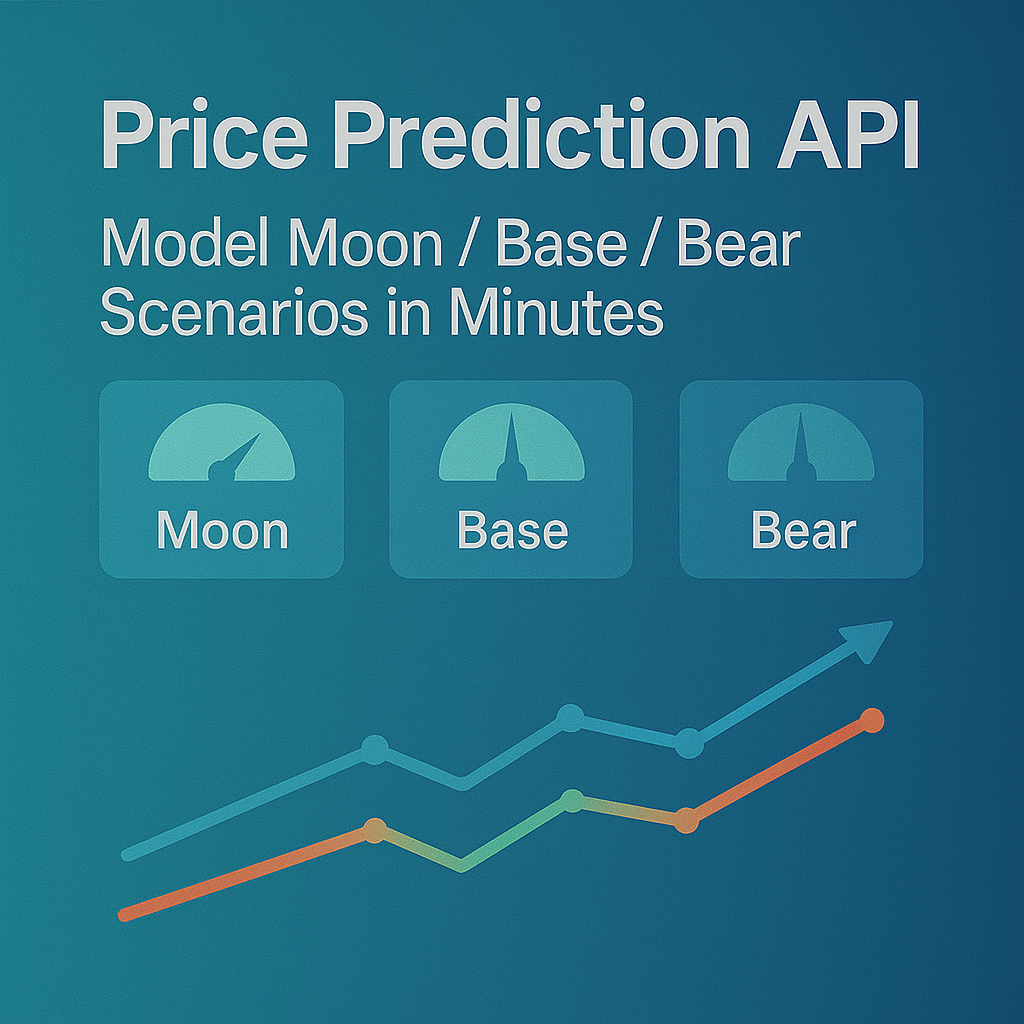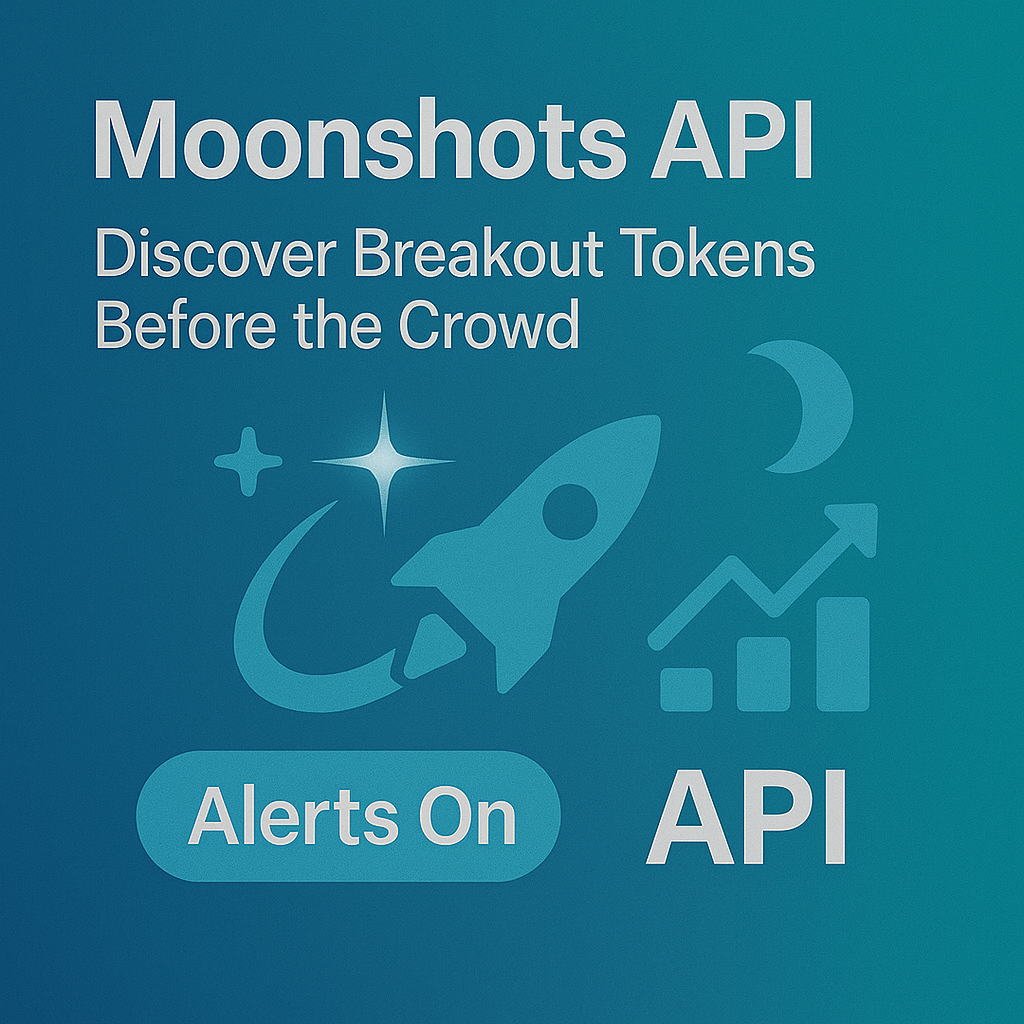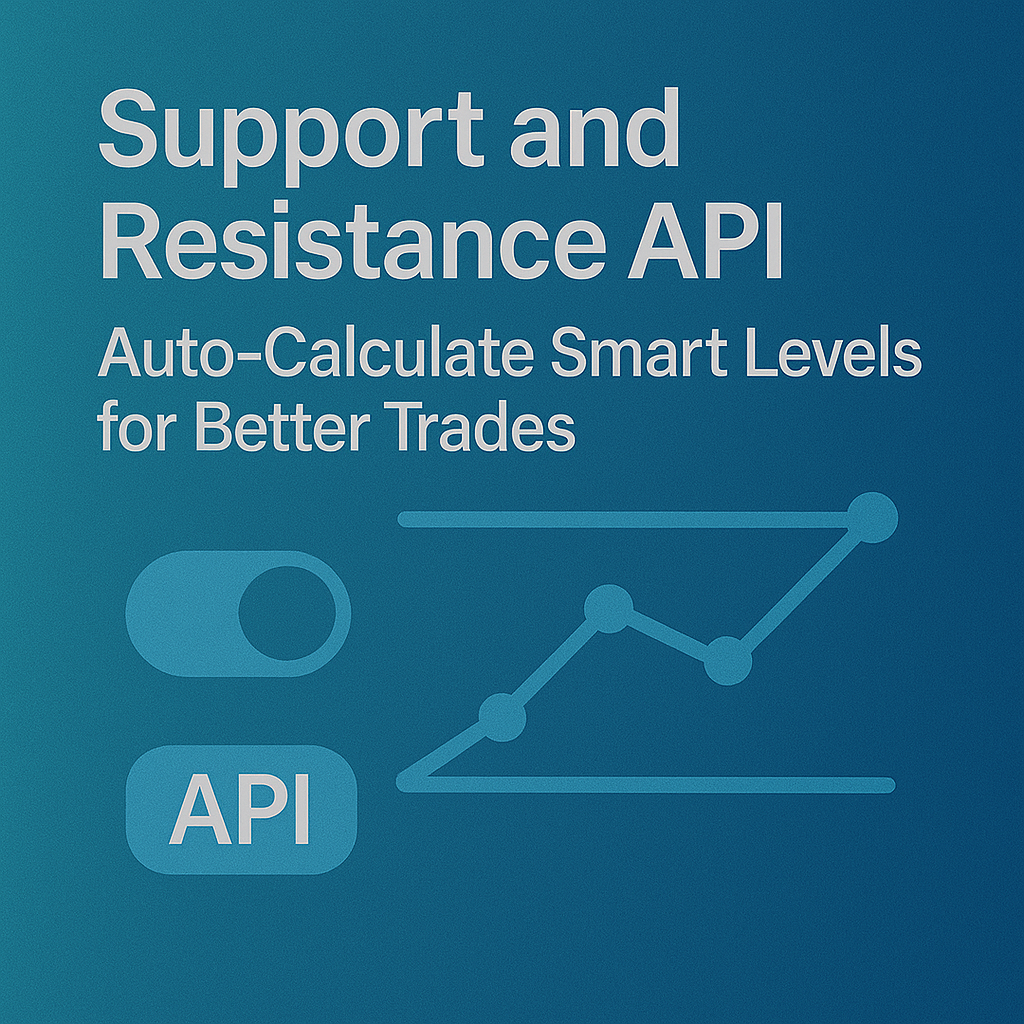Top Crypto Trading Platforms in 2025







%201.svg)
%201.svg)
Big news: We’re cranking up the heat on AI-driven crypto analytics with the launch of the Token Metrics API and our official SDK (Software Development Kit). This isn’t just an upgrade – it's a quantum leap, giving traders, hedge funds, developers, and institutions direct access to cutting-edge market intelligence, trading signals, and predictive analytics.
Crypto markets move fast, and having real-time, AI-powered insights can be the difference between catching the next big trend or getting left behind. Until now, traders and quants have been wrestling with scattered data, delayed reporting, and a lack of truly predictive analytics. Not anymore.
The Token Metrics API delivers 32+ high-performance endpoints packed with powerful AI-driven insights right into your lap, including:
Getting started with the Token Metrics API is simple:
At Token Metrics, we believe data should be decentralized, predictive, and actionable.
The Token Metrics API & SDK bring next-gen AI-powered crypto intelligence to anyone looking to trade smarter, build better, and stay ahead of the curve. With our official SDK, developers can plug these insights into their own trading bots, dashboards, and research tools – no need to reinvent the wheel.
%201.svg)
%201.svg)
The biggest gains in crypto rarely come from the majors. They come from Moonshots—fast-moving tokens with breakout potential. The Moonshots API surfaces these candidates programmatically so you can rank, alert, and act inside your product. In this guide, you’ll call /v2/moonshots, display a high-signal list with TM Grade and Bullish tags, and wire it into bots, dashboards, or screeners in minutes. Start by grabbing your key at Get API Key, then Run Hello-TM and Clone a Template to ship fast.
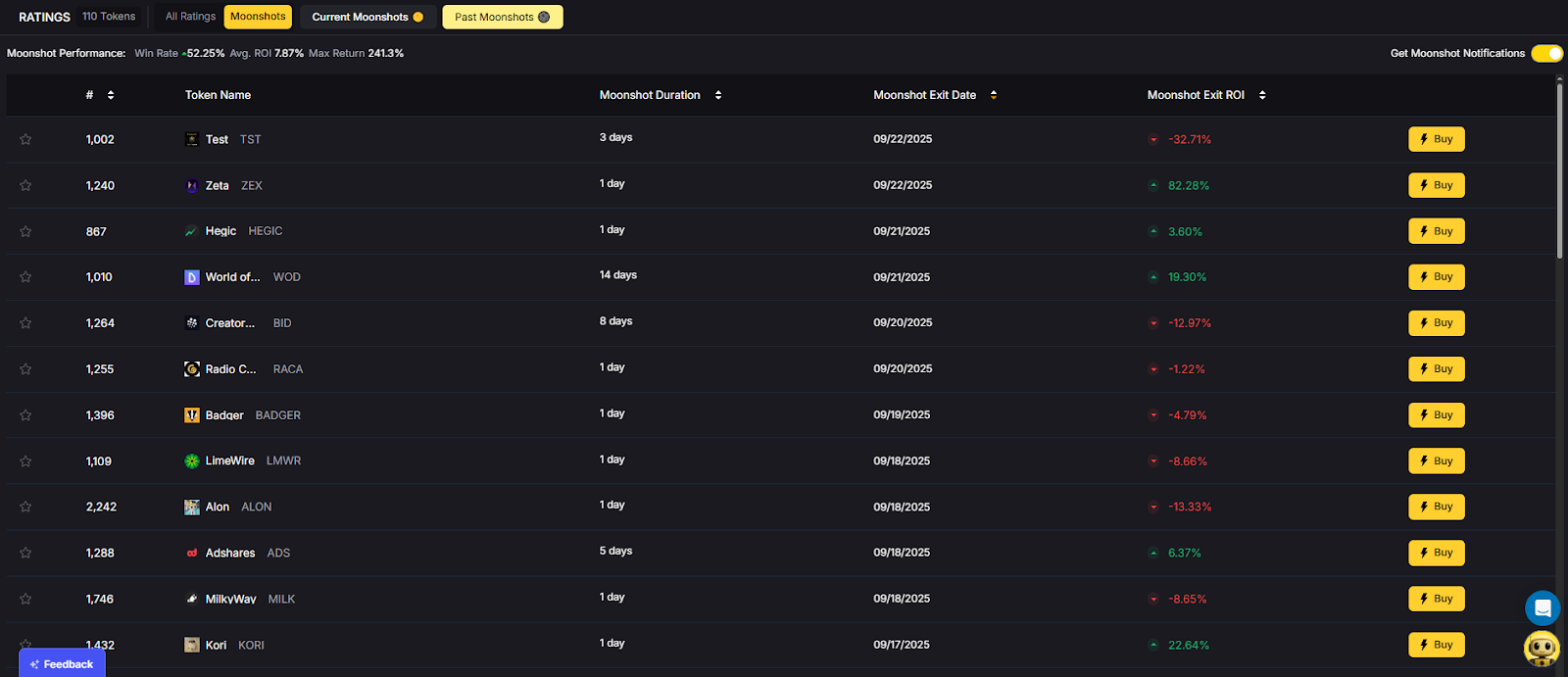
Discovery that converts. Users want more than price tickers—they want a curated, explainable list of high-potential tokens. The moonshots API encapsulates multiple signals into a short list designed for exploration, alerts, and watchlists you can monetize.
Built for builders. The endpoint returns a consistent schema with grade, signal, and context so you can immediately sort, badge, and trigger workflows. With predictable latency and clear filters, you can scale to dashboards, mobile apps, and headless bots without reinventing the discovery pipeline.
The Moonshots API cURL request is right there in the top right of the API Reference. Grab it and start tapping into the potential!
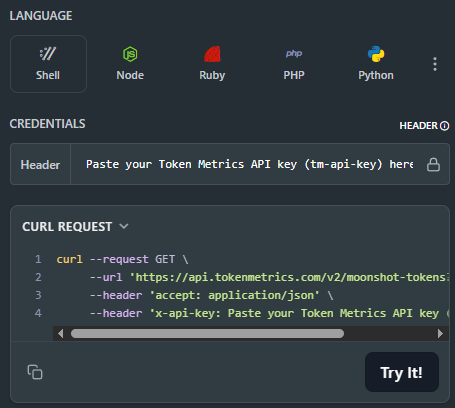
👉 Keep momentum: Get API Key • Run Hello-TM • Clone a Template
Fork a screener or alerting template, plug your key, and deploy. Validate your environment with Hello-TM. When you scale users or need higher limits, compare API plans.
The Moonshots endpoint aggregates a set of evidence—often combining TM Grade, signal state, and momentum/volume context—into a shortlist of breakout candidates. Each row includes a symbol, grade, signal, and timestamp, plus optional reason tags for transparency.
For UX, a common pattern is: headline list → token detail where you render TM Grade (quality), Trading Signals (timing), Support/Resistance (risk placement), Quantmetrics (risk-adjusted performance), and Price Prediction scenarios. This lets users understand why a token was flagged and how to act with risk controls.
Polling vs webhooks. Dashboards typically poll with short-TTL caching. Alerting flows use scheduled jobs or webhooks (where available) to smooth traffic and avoid duplicates. Always make notifications idempotent.
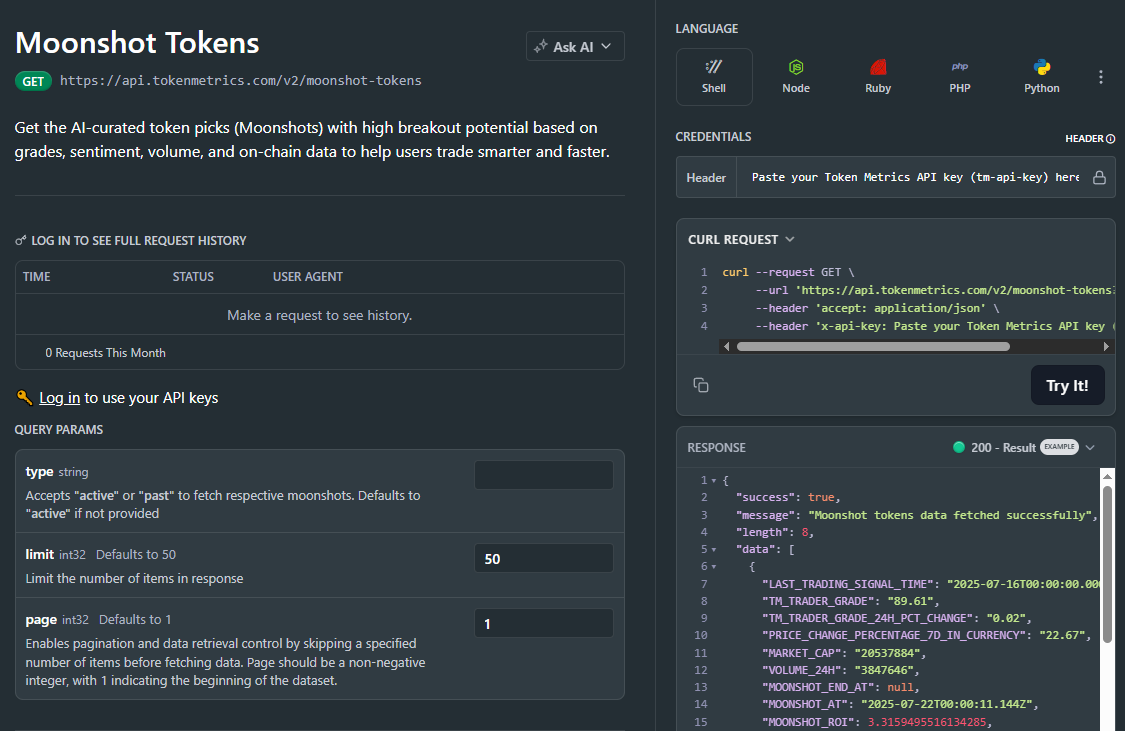
1) What does the Moonshots API return?
A list of breakout candidates with fields such as symbol, tm_grade, signal (often Bullish/Bearish), optional reason tags, and updated_at. Use it to drive discover tabs, alerts, and watchlists.
2) How fresh is the list? What about latency/SLOs?
The endpoint targets predictable latency and timely updates for dashboards and alerts. Use short-TTL caching and queued jobs/webhooks to avoid bursty polling.
3) How do I use Moonshots in a trading workflow?
Common stack: Moonshots for discovery, Trading Signals for timing, Support/Resistance for SL/TP, Quantmetrics for sizing, and Price Prediction for scenario context. Always backtest and paper-trade first.
4) I saw results like “+241%” and a “7.5% average return.” Are these guaranteed?
No. Any historical results are illustrative and not guarantees of future performance. Markets are risky; use risk management and testing.
5) Can I filter the Moonshots list?
Yes—pass parameters like min_grade, signal, and limit (as supported) to tailor to your audience and keep pages fast.
6) Do you provide SDKs or examples?
REST works with JavaScript and Python snippets above. Docs include quickstarts, Postman collections, and templates—start with Run Hello-TM.
7) Pricing, limits, and enterprise SLAs?
Begin free and scale up. See API plans for rate limits and enterprise options.
%201.svg)
%201.svg)
Most traders still draw lines by hand in TradingView. The support and resistance API from Token Metrics auto-calculates clean support and resistance levels from one request, so your dashboard, bot, or alerts can react instantly. In minutes, you’ll call /v2/resistance-support, render actionable levels for any token, and wire them into stops, targets, or notifications. Start by grabbing your key on Get API Key, then Run Hello-TM and Clone a Template to ship a production-ready feature fast.
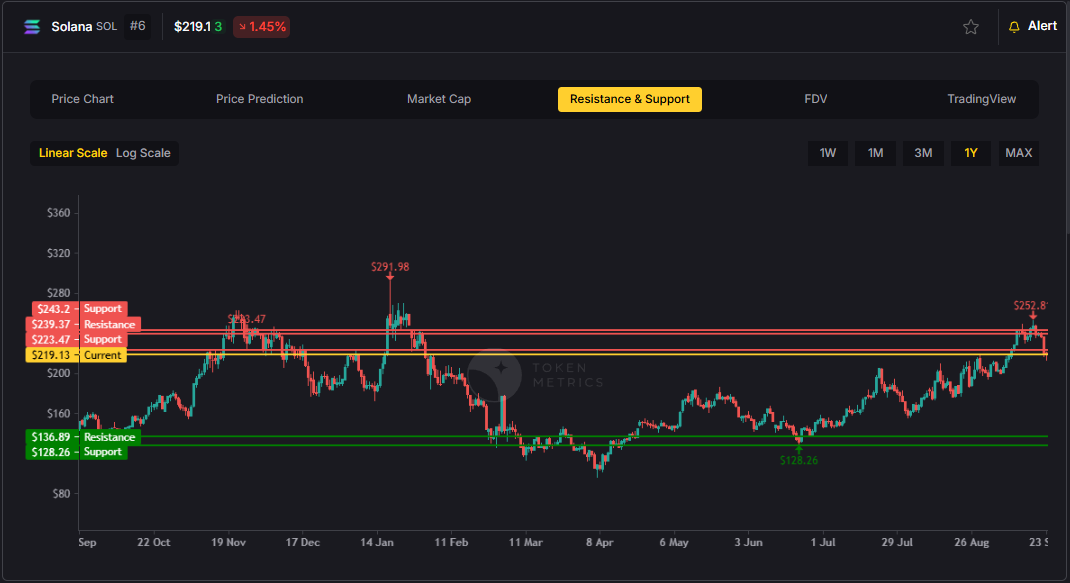
Precision beats guesswork. Hand-drawn lines are subjective and slow. The support and resistance API standardizes levels across assets and timeframes, enabling deterministic stops and take-profits your users (and bots) can trust.
Production-ready by design. A simple REST shape, predictable latency, and clear semantics let you add levels to token pages, automate SL/TP alerts, and build rule-based execution with minimal glue code.
Need the Support and Resistance data? The cURL request for it is in the top right of the API Reference for quick access.
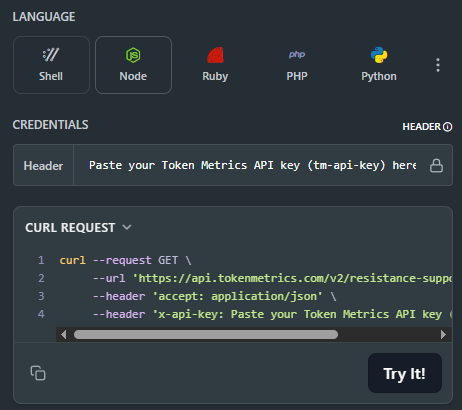
👉 Keep momentum: Get API Key • Run Hello-TM • Clone a Template
Kick off with our quickstarts—fork a bot or dashboard template, plug your key, and deploy. Confirm your environment by Running Hello-TM. When you’re scaling or need webhooks/limits, review API plans.
The Support/Resistance endpoint analyzes recent price structure to produce discrete levels above and below current price, along with strength indicators you can use for priority and styling. Query /v2/resistance-support?symbol=<ASSET>&timeframe=<HORIZON> to receive arrays of level objects and timestamps.
Polling vs webhooks. For dashboards, short-TTL caching and batched fetches keep pages snappy. For bots and alerts, use queued jobs or webhooks (where applicable) to avoid noisy, bursty polling—especially around market opens and major events.
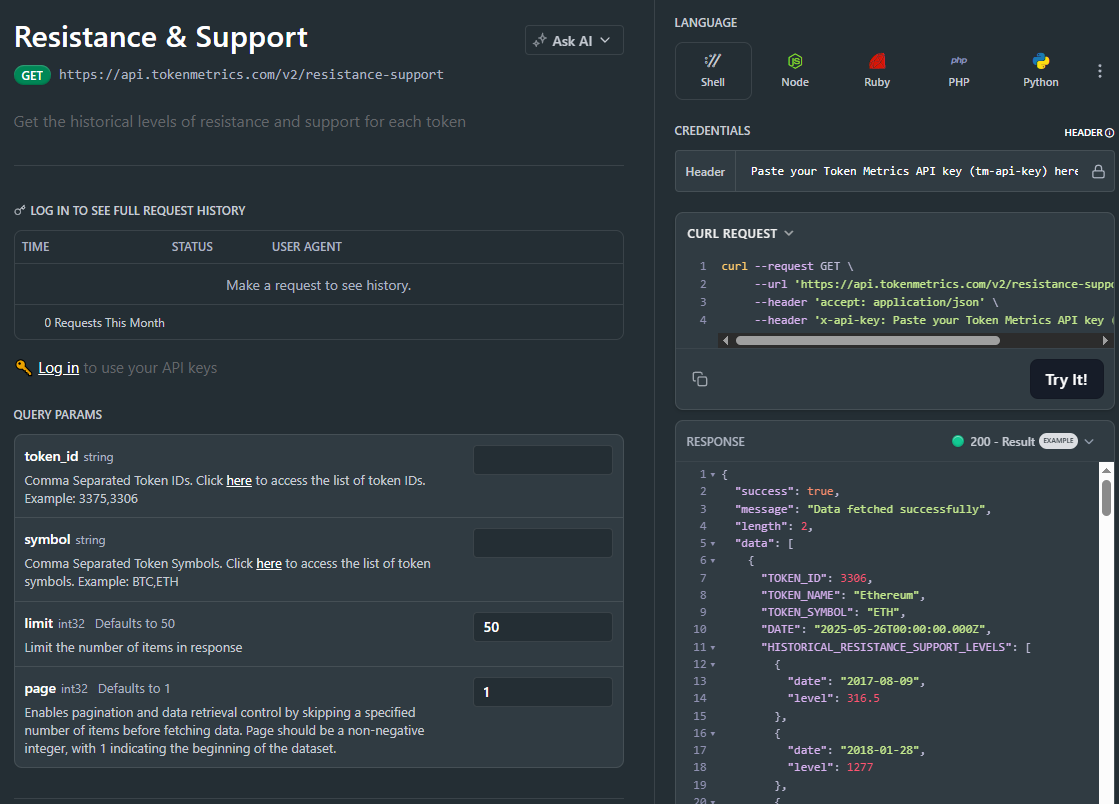
1) What does the Support & Resistance API return?
A JSON payload with arrays of support and resistance levels for a symbol (and optional timeframe), each with a price and strength indicator, plus an update timestamp.
2) How timely are the levels? What are the latency/SLOs?
The endpoint targets predictable latency suitable for dashboards and alerts. Use short-TTL caching for UIs, and queued jobs or webhooks for alerting to smooth traffic.
3) How do I trigger alerts or trades from levels?
Common patterns: alert when price is within X% of a level, touches a level, or breaks beyond with confirmation. Always make downstream actions idempotent and respect rate limits.
4) Can I combine levels with other endpoints?
Yes—pair with /v2/trading-signals for timing, /v2/tm-grade for quality context, and /v2/quantmetrics for risk sizing. This yields a complete decide-plan-execute loop.
5) Which timeframe should I use?
Intraday bots prefer shorter horizons; swing/position dashboards use daily or higher-timeframe levels. Offer a timeframe toggle and cache results per setting.
6) Do you provide SDKs or examples?
Use the REST snippets above (JS/Python). The docs include quickstarts, Postman collections, and templates—start with Run Hello-TM.
7) Pricing, limits, and enterprise SLAs?
Begin free and scale as you grow. See API plans for rate limits and enterprise SLA options.
%201.svg)
%201.svg)
Most traders see price—quants see probabilities. The Quantmetrics API turns raw performance into risk-adjusted stats like Sharpe, Sortino, volatility, drawdown, and CAGR so you can compare tokens objectively and build smarter bots and dashboards. In minutes, you’ll query /v2/quantmetrics, render a clear performance snapshot, and ship a feature that customers trust. Start by grabbing your key at Get API Key, Run Hello-TM to verify your first call, then Clone a Template to go live fast.
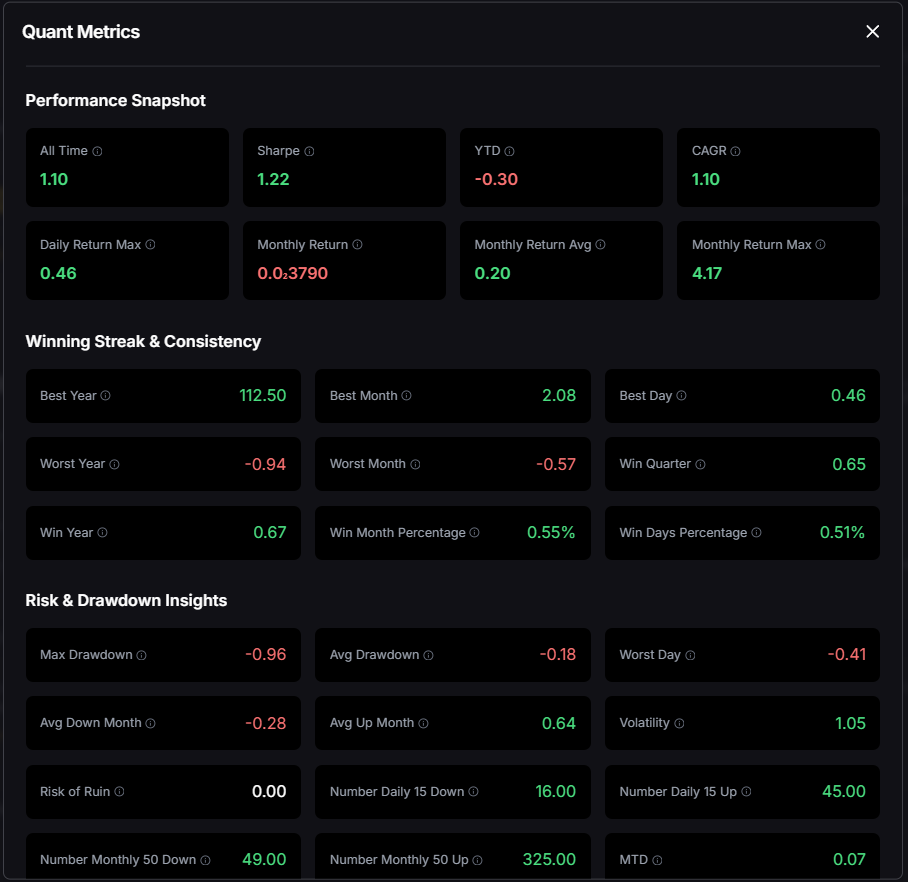
Risk-adjusted truth beats hype. Price alone hides tail risk and whipsaws. Quantmetrics compresses edge, risk, and consistency into metrics that travel across assets and timeframes—so you can rank universes, size positions, and communicate performance like a pro.
Built for dev speed. A clean REST schema, predictable latency, and easy auth mean you can plug Sharpe/Sortino into bots, dashboards, and screeners without maintaining your own analytics pipeline. Pair with caching and batching to serve fast pages at scale.
The Quant Metrics cURL request is located in the top right of the API Reference, allowing you to easily integrate it with your application.
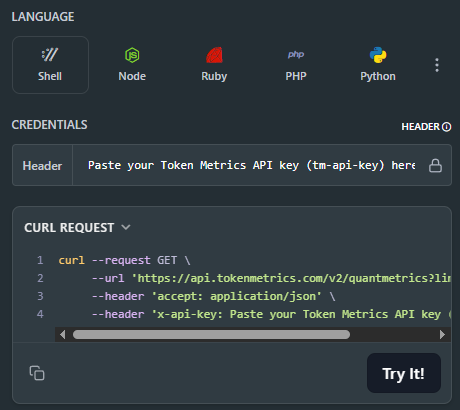
👉 Keep momentum: Get API Key • Run Hello-TM • Clone a Template
Kick off from quickstarts in the docs—fork a dashboard or screener template, plug your key, and deploy in minutes. Validate your environment with Run Hello-TM; when you need more throughput or webhooks, compare API plans.
Quantmetrics computes risk-adjusted performance over a chosen lookback (e.g., 30d, 90d, 1y). You’ll receive a JSON snapshot with core statistics:
Call /v2/quantmetrics?symbol=<ASSET>&window=<LOOKBACK> to fetch the current snapshot. For dashboards spanning many tokens, batch symbols and apply short-TTL caching. If you generate alerts (e.g., “Sharpe crossed 1.5”), run a scheduled job and queue notifications to avoid bursty polling.
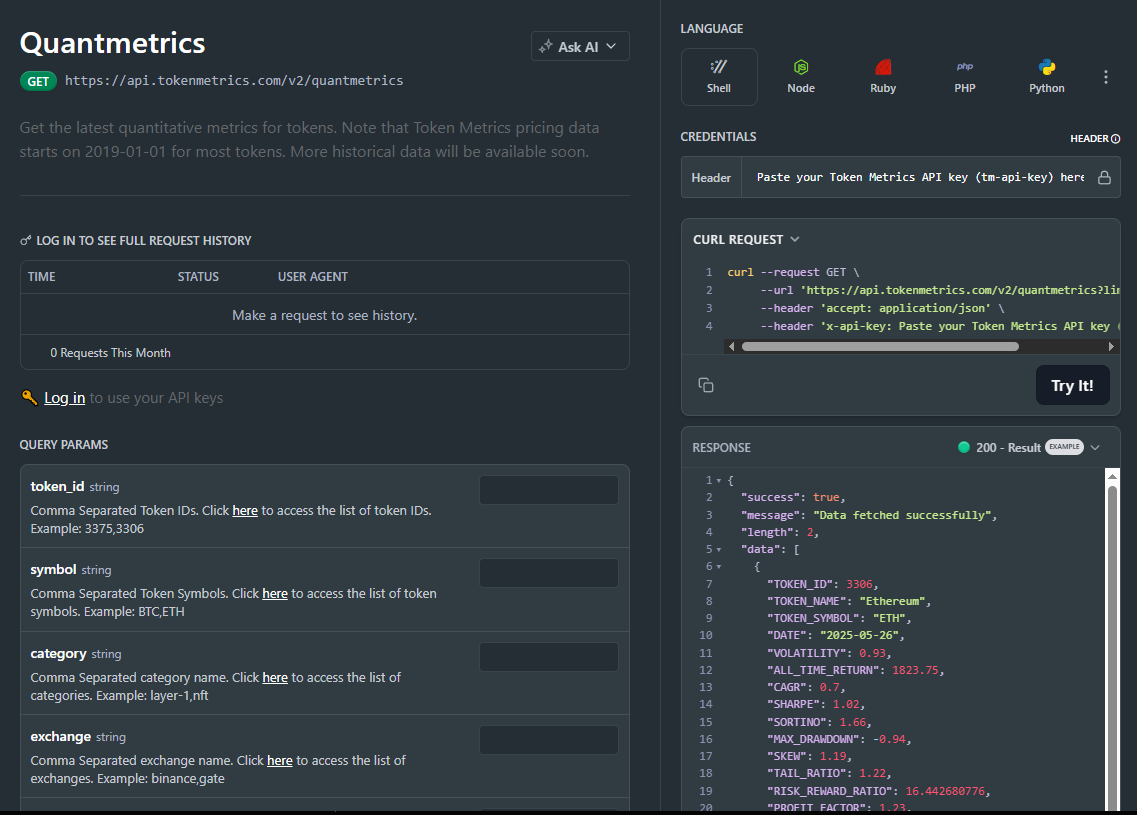
1) What does the Quantmetrics API return?
A JSON snapshot of risk-adjusted metrics (e.g., Sharpe, Sortino, volatility, max drawdown, CAGR) for a symbol and lookback window—ideal for ranking, sizing, and dashboards.
2) How fresh are the stats? What about latency/SLOs?
Responses are engineered for predictable latency. For heavy UI usage, add short-TTL caching and batch requests; for alerts, use scheduled jobs or webhooks where available.
3) Can I use Quantmetrics to size positions in a live bot?
Yes—many quants size inversely to volatility or require Sharpe ≥ X to trade. Always backtest and paper-trade before going live; past results are illustrative, not guarantees.
4) Which lookback window should I choose?
Short windows (30–90d) adapt faster but are noisier; longer windows (6–12m) are steadier but slower to react. Offer users a toggle and cache each window.
5) Do you provide SDKs or examples?
REST is straightforward (JS/Python above). Docs include quickstarts, Postman collections, and templates—start with Run Hello-TM.
6) Polling vs webhooks for quant alerts?
Dashboards usually use cached polling. For threshold alerts (e.g., Sharpe crosses 1.0), run scheduled jobs and queue notifications to keep usage smooth and idempotent.
7) Pricing, limits, and enterprise SLAs?
Begin free and scale up. See API plans for rate limits and enterprise SLA options.

%201.svg)
%201.svg)
In the world of blockchain, consensus mechanisms are what keep networks secure and functional. One of the most important of these is Proof of Stake (PoS)—a model that has become the standard for next‑generation blockchains like Ethereum, Cardano, and Solana.
In 2025, PoS dominates the crypto landscape, offering a more energy‑efficient, scalable, and inclusive alternative to the older Proof of Work (PoW) model. This article breaks down how PoS works, why it matters, its benefits and risks, and how platforms like Token Metrics can help investors optimize staking strategies.
Proof of Stake is a consensus mechanism that allows blockchains to validate transactions and create new blocks based on the number of tokens held (or “staked”) by network participants.
Instead of using powerful computers to solve complex puzzles (as in Proof of Work), PoS relies on validators—individuals or entities who lock up tokens as collateral to help maintain the network.
In return, these validators earn staking rewards, making PoS not only an essential part of blockchain operations but also a way for investors to generate passive income.
Proof of Work (PoW):
Proof of Stake (PoS):
In 2025, PoS is considered the future of blockchain consensus thanks to its efficiency and accessibility.
While PoS is revolutionary, it’s not without challenges:
Platforms like Token Metrics help mitigate these risks by offering in‑depth analytics on validators, staking pools, and network activity.
1. Solo Staking:
Run your own validator node. This requires technical expertise and meeting minimum staking requirements (e.g., 32 ETH for Ethereum).
2. Pooled Staking:
Join staking pools that combine funds from multiple users, making it easier for beginners to participate.
3. Liquid Staking:
Use platforms like Lido or Rocket Pool to stake while maintaining liquidity through derivative tokens you can trade or use in DeFi.
4. Exchange Staking:
Centralized exchanges (e.g., Coinbase, Binance) offer simple staking options, though they often take a fee.

Token Metrics empowers PoS investors with:
This makes staking easier, safer, and more profitable for both beginners and experienced investors.
In 2025, PoS is expected to power the majority of leading blockchains, supporting innovations in DeFi, NFTs, AI‑driven ecosystems, and real‑world asset tokenization.
Its combination of efficiency, scalability, and accessibility makes it the go‑to consensus mechanism for the next era of Web3 development.
Proof of Stake has redefined how blockchains achieve consensus, making networks more sustainable, secure, and inclusive. For investors, PoS offers an exciting opportunity to earn passive income while supporting blockchain ecosystems.
By leveraging AI‑powered analytics from Token Metrics, you can maximize staking rewards, identify top‑performing validators, and manage risk effectively.
In 2025, understanding PoS isn’t just for developers—it’s an essential tool for every crypto investor.
_%20A%20Complete%20Guide%20to%20the%20Meme%20Coin%20in%202025.png)
%201.svg)
%201.svg)
Shiba Inu (SHIB) started in 2020 as a meme coin inspired by Dogecoin, but in a few short years, it has evolved into one of the largest and most recognizable cryptocurrencies in the world. Initially dismissed as a joke, Shiba Inu has since built an entire ecosystem of decentralized products, proving that meme coins can grow beyond viral popularity.
In 2025, Shiba Inu continues to maintain a massive community, a growing ecosystem, and a spot among the top cryptocurrencies by market cap. This article explores what Shiba Inu is, how its ecosystem works, its investment potential, and how platforms like Token Metrics can help analyze SHIB effectively.

Shiba Inu (SHIB) is an Ethereum‑based token designed to be an experiment in decentralized community building. Dubbed the “Dogecoin killer,” SHIB quickly gained traction thanks to its strong community (the SHIBArmy), viral marketing, and accessibility across major exchanges.
Unlike Bitcoin or Ethereum, SHIB is not a blockchain in itself—it’s an ERC‑20 token that runs on the Ethereum network.
Since its launch, Shiba Inu has expanded far beyond being just a meme token. Its ecosystem now includes:
1. Strong Community (SHIBArmy):
One of the most active and loyal crypto communities drives the project’s growth.
2. Accessibility:
Listed on most major exchanges, SHIB is easy for new investors to buy.
3. Low Entry Point:
With its large supply and low price per token, SHIB appeals to retail investors looking for affordable exposure.
4. Viral Marketing:
Its meme‑driven branding keeps it relevant and highly visible in social media trends.
As an ERC‑20 token, SHIB benefits from the security and scalability of the Ethereum blockchain. The ecosystem uses:
Although both are dog‑themed meme coins, they differ significantly:
In 2025, Shiba Inu’s ecosystem gives it a competitive edge over Dogecoin in terms of utility.
Shiba Inu’s price has experienced extreme volatility since launch, but it remains a top‑20 cryptocurrency by market cap.
Growth drivers include:
For investors, SHIB offers speculative upside, but it’s best approached as part of a diversified portfolio.
While SHIB has strong community support, it carries notable risks:
Investing in Shiba Inu requires data‑driven decision‑making, and that’s where Token Metrics comes in:
This AI‑driven approach helps investors separate hype from sustainable growth.
In 2025, Shiba Inu aims to transition from meme coin to multi‑utility ecosystem, expanding its role in DeFi, metaverse applications, and Layer 2 scaling solutions. Its success will depend on community engagement, continued innovation, and adoption of Shibarium.
Shiba Inu has proven that meme coins can evolve into meaningful projects. With its Layer 2 network, DeFi ecosystem, and strong community, SHIB is more than just internet hype—it’s a project with growing utility and staying power.
For investors, pairing SHIB exposure with AI‑powered insights from Token Metrics provides a smarter way to navigate the volatility of meme coins while capitalizing on their growth potential.
_%20A%20Complete%20Guide%20to%20Ethereum%E2%80%99s%20Native%20Token%20in%202025.png)
%201.svg)
%201.svg)
Ether (ETH) is the native cryptocurrency of the Ethereum blockchain, powering one of the most influential ecosystems in the crypto world. Since its launch in 2015, Ethereum has evolved from a simple smart contract platform into a global hub for decentralized finance (DeFi), NFTs, real‑world asset tokenization (RWA), and blockchain‑based applications.
In 2025, Ether remains a cornerstone of crypto portfolios, offering not only investment potential but also utility within Ethereum’s constantly expanding network. This article breaks down what Ether is, how it works, why it’s valuable, and how platforms like Token Metrics help investors analyze ETH effectively.
Ether (ETH) is the cryptocurrency used to pay for transactions, smart contract execution, and services on the Ethereum network. While Bitcoin is often referred to as “digital gold,” Ether functions as both a digital asset and a fuel (commonly called “gas”) for running decentralized applications (dApps).

Key roles of Ether:
Ethereum is a decentralized, programmable blockchain that allows developers to create and deploy dApps. It introduced smart contracts—self‑executing agreements that operate without intermediaries.
In 2022, Ethereum completed The Merge, transitioning from Proof of Work (PoW) to Proof of Stake (PoS). This shift reduced energy consumption by over 99% and enabled ETH holders to stake their tokens to earn passive rewards.
Ether remains one of the most versatile and valuable cryptocurrencies in the market:
In 2025, Ethereum continues to dominate the decentralized finance (DeFi) space. DeFi protocols like Uniswap, Aave, and MakerDAO run on Ethereum, using Ether as collateral or for gas fees.
Why this matters for investors:
1. Buying ETH:
Ether is available on major crypto exchanges such as Coinbase, Binance, and decentralized platforms like Uniswap.
2. Storing ETH:
Use:
3. Staking ETH:
Stake ETH directly through Ethereum validators or staking platforms to earn rewards while supporting the network.
While Bitcoin and Ether are both top cryptocurrencies, they serve different purposes:
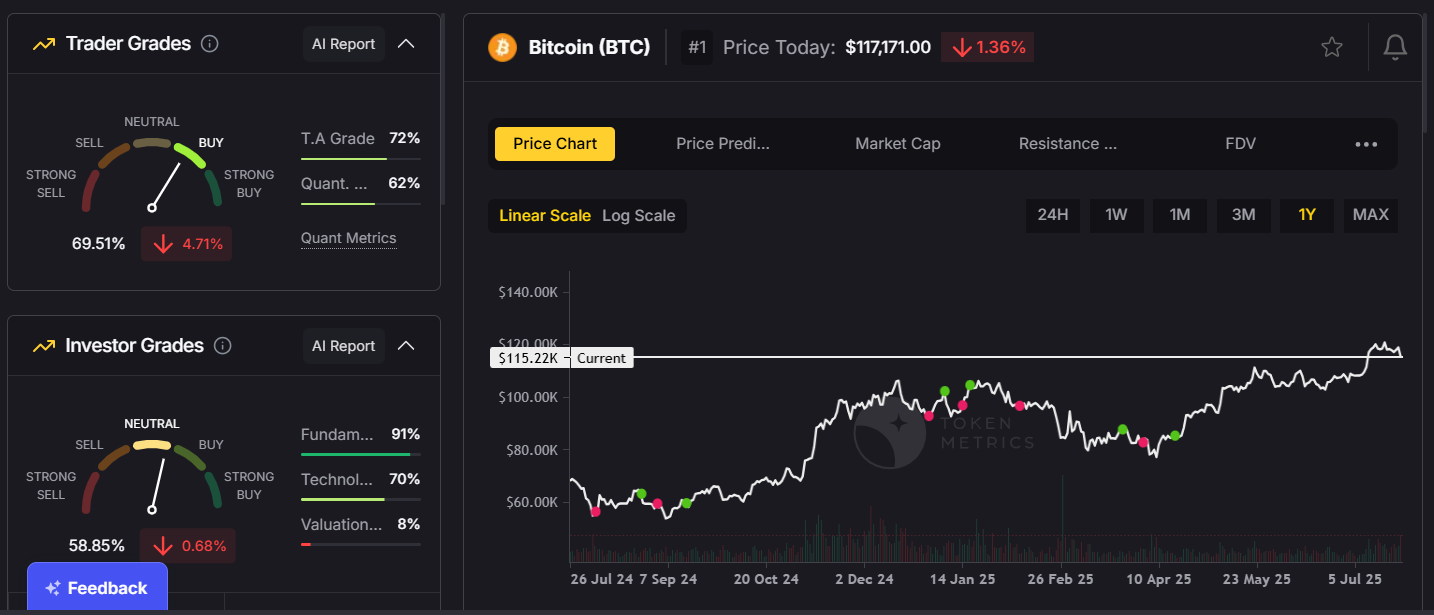
In 2025, ETH has positioned itself as a growth‑driven crypto asset, while Bitcoin remains the ultimate store of value.
With Ethereum’s upgrades and institutional adoption, many analysts expect ETH to outperform in the coming cycle. Key growth drivers include:
Token Metrics offers AI‑powered tools that make investing in ETH smarter:
This gives ETH investors a competitive edge in volatile markets.
While ETH has strong fundamentals, risks remain:
Using Token Metrics helps mitigate these risks by providing real‑time analytics and portfolio insights.
Ether is more than just another cryptocurrency—it’s the lifeblood of the Ethereum ecosystem, powering decentralized applications, DeFi, NFTs, and enterprise solutions.
In 2025, holding ETH offers exposure to one of the most innovative and widely used blockchain platforms, making it a must‑have for serious crypto investors.
By combining long‑term holding strategies with AI‑powered insights from Token Metrics, investors can confidently navigate Ethereum’s growth trajectory and maximize returns in the years ahead.

%201.svg)
%201.svg)
Altcoin bull runs are some of the most exciting periods in cryptocurrency, delivering life‑changing gains for prepared investors. These cycles often follow or coincide with Bitcoin rallies, as capital flows into smaller, high‑growth tokens in search of outsized returns.
In 2025, with AI‑powered platforms, institutional adoption, and innovative sectors like DeFi, AI tokens, and real‑world assets (RWAs) driving growth, the stage is set for a potentially historic altcoin bull run. This guide explains how to prepare, what to watch for, and how tools like Token Metrics can help you capitalize on this opportunity.
Understanding what drives these rallies is key to recognizing when one begins.

Preparation is everything. Here’s how to position yourself before the market takes off:
1. Build a Diversified Portfolio:
Combine large‑cap coins (Ethereum, Solana) with high‑potential small‑caps like Token Metrics AI (TMAI) or narrative‑driven DeFi tokens.
2. Use AI‑Powered Analytics:
Token Metrics leverages over 80 data points per token—including technicals, fundamentals, and sentiment—to help you spot early movers before the crowd.
3. Set Entry and Exit Plans:
Define profit targets and stop‑loss levels before entering trades to avoid emotional decisions during volatility.
4. Stay Liquid:
Keep a portion of your portfolio in stablecoins to seize opportunities during sharp pullbacks.

The next altcoin season will likely be driven by powerful narratives:
With great opportunity comes great risk. Here’s how to protect your gains:
Token Metrics is an essential tool for navigating altcoin bull markets, offering:
This data‑driven approach helps investors stay ahead of the crowd and avoid emotional decision‑making during fast‑moving markets.
As crypto matures, AI‑enhanced analytics, regulatory clarity, and wider institutional adoption are likely to make future altcoin seasons more sustainable and inclusive.
In 2025, the winners will be those who combine smart preparation, narrative awareness, and AI‑powered tools like Token Metrics to maximize returns.
The 2025 altcoins bull run could be one of the most lucrative in crypto history, but success requires preparation, strategy, and discipline.
By diversifying across high‑potential narratives, using AI‑driven insights from Token Metrics, and following a clear plan, you can profit from explosive growth while managing risk effectively.
In altcoin bull runs, timing, data, and psychology are everything—get them right, and the opportunities are limitless.
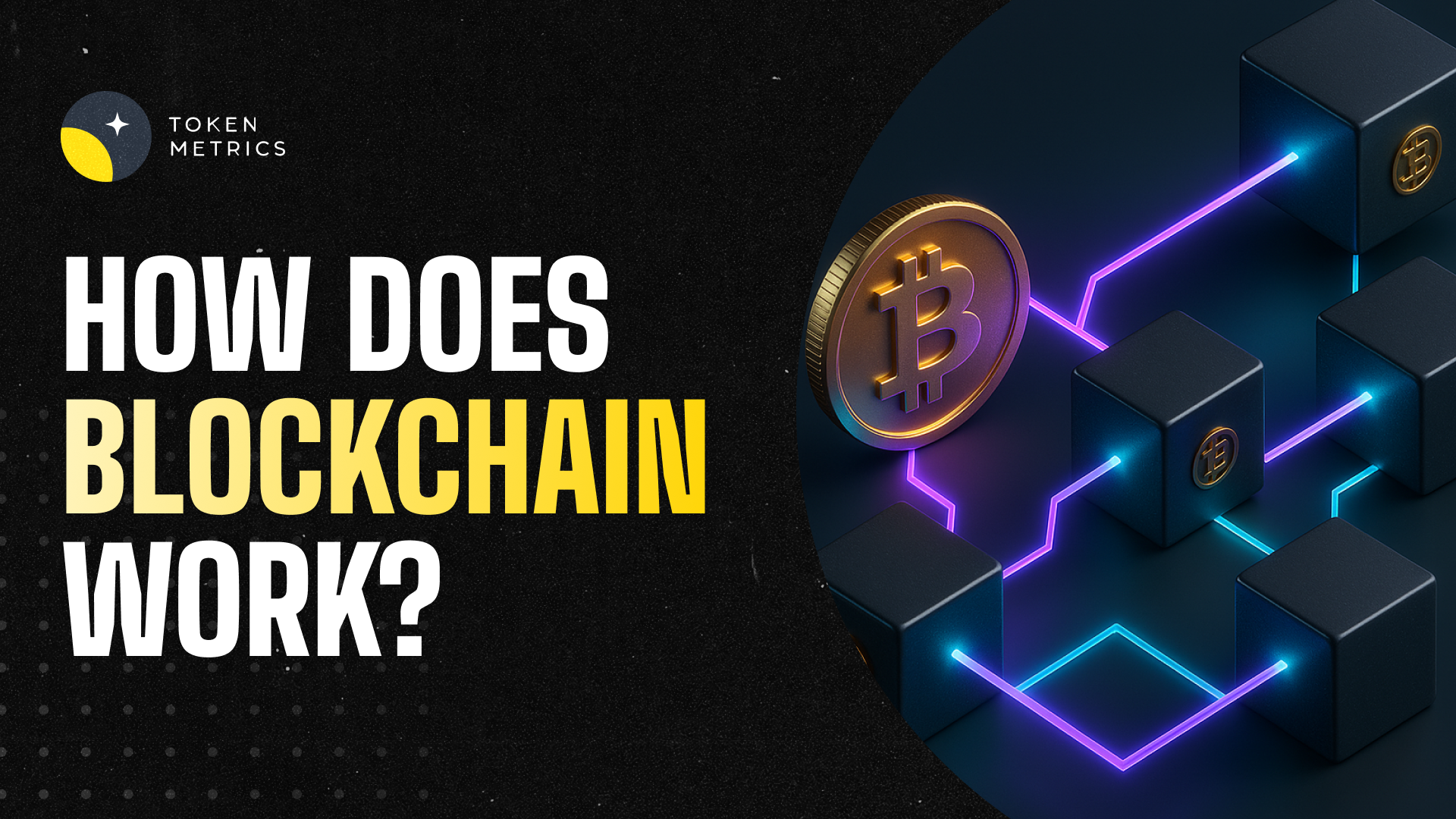
%201.svg)
%201.svg)
Blockchain is the foundation of modern cryptocurrency and one of the most transformative technologies of the digital age. Initially created to support Bitcoin, blockchain has expanded into countless use cases, from decentralized finance (DeFi) to supply chain tracking, real-world asset tokenization, and artificial intelligence (AI) integration.
In 2025, understanding how blockchain works is essential—not just for crypto investors but for anyone navigating the evolving digital economy. This article explains the structure, components, and applications of blockchain in simple terms and explores how platforms like Token Metrics use blockchain data to help investors make smarter decisions.
At its core, blockchain is a distributed digital ledger that records transactions across a network of computers. Unlike traditional databases controlled by a single entity, blockchain operates on a decentralized network, making it secure, transparent, and tamper-resistant.
Each entry in this ledger is grouped into a “block,” and these blocks are linked (or chained) together in chronological order—hence the name blockchain.
Consensus mechanisms are protocols that ensure all nodes agree on the state of the blockchain.
In 2025, hybrid models combining public and private features are increasingly popular for balancing transparency with privacy.
Platforms like Token Metrics take blockchain a step further by:
By combining blockchain transparency with AI-powered analytics, Token Metrics provides a comprehensive view of crypto investments.
In 2025, blockchain continues to evolve beyond cryptocurrencies. With advances in scalability solutions, real-world asset tokenization, and AI integration, blockchain is shaping the next generation of financial systems, digital identity solutions, and decentralized applications.
As enterprises, governments, and investors adopt blockchain, its role in the digital economy will only grow.
Blockchain is more than a buzzword—it’s a transformative technology driving innovation across industries. By understanding how blockchain works—its structure, consensus mechanisms, and applications—you can better navigate the crypto market and the broader digital landscape.
Platforms like Token Metrics make blockchain analysis accessible and actionable, offering AI-driven insights to help investors capitalize on this rapidly expanding technology. In 2025, mastering blockchain fundamentals isn’t just helpful—it’s essential for participating in the future of finance and digital ownership.

%201.svg)
%201.svg)
In the fast-paced world of cryptocurrency investing, market capitalization, often called market cap, is one of the most essential metrics for evaluating projects. It helps investors quickly gauge a coin’s size, value, and growth potential, making it a cornerstone for portfolio allocation and risk management.
Whether you’re a beginner trying to understand which cryptocurrencies to buy or an experienced trader managing a complex portfolio, understanding coin market cap is critical. In this guide, we’ll break down what market cap is, how to use it effectively, its limitations, and how platforms like Token Metrics can enhance your analysis with advanced data insights.
Market capitalization refers to the total value of a cryptocurrency in circulation. It’s calculated using a simple formula:
Market Cap=Current Price×Circulating Supply\text{Market Cap} = \text{Current Price} \times \text{Circulating Supply}

For example, if a cryptocurrency is priced at $20 and has 50 million coins in circulation, its market cap would be $1 billion. This figure provides a snapshot of the project’s relative size and its standing in the broader crypto market.
Market cap is an invaluable metric for quickly comparing projects, identifying potential opportunities, and understanding the level of risk associated with an investment.
Market cap plays a crucial role in crypto investing for several reasons:
Cryptocurrencies are typically categorized by their market cap:
While market cap is only one part of the puzzle, it’s a powerful tool when used correctly. Here’s how to incorporate it into your strategy:
Although market cap is a useful metric, it has its shortcomings:
This is why market cap analysis should always be combined with other key metrics and qualitative research, which is where Token Metrics becomes invaluable.
While traditional market cap data offers a snapshot, Token Metrics goes deeper by analyzing:
This AI-powered approach allows investors to identify truly undervalued projects that might be overlooked by simply glancing at market cap.
Market cap is most powerful when used alongside:
Combining these insights with market cap offers a more complete view of a project’s health and potential.
Coin market cap remains one of the most fundamental metrics for analyzing cryptocurrencies. It provides a clear picture of project size and helps investors allocate capital effectively.
However, market cap alone isn’t enough. To make smarter, data-driven decisions, investors should combine market cap insights with on-chain data, technical analysis, and AI-driven insights from Token Metrics.
In 2025, using market cap alongside advanced analytics can help you identify undervalued opportunities, manage risk effectively, and build a balanced, growth-oriented crypto portfolio.

%201.svg)
%201.svg)
Over the past decade, cryptocurrency has moved from an experimental technology to a mainstream investment asset. What started with Bitcoin as a digital alternative to cash has evolved into a multi-trillion-dollar ecosystem encompassing altcoins, decentralized finance (DeFi), AI-powered tokens, and NFTs.
In 2025, crypto is no longer a fringe idea—it’s an essential consideration for forward-thinking investors. Whether you’re seeking growth, diversification, or a hedge against inflation, crypto offers multiple paths to wealth creation. This article explores why crypto is a valuable investment, how to approach it strategically, and the role of Token Metrics in making data-driven decisions.

Mitigate these risks by conducting thorough research and using Token Metrics AI to assess tokens based on fundamentals, on-chain activity, and market sentiment.

Token Metrics is a game-changing platform for crypto investors. It provides AI-powered coin ratings, trend analysis, and portfolio management tools. With over 80 data points per token, it helps investors identify undervalued coins and time market entries effectively.
In 2025, crypto remains a compelling investment option for those willing to manage its risks. By leveraging Token Metrics for data-driven insights and combining long-term strategies with diversified holdings, investors can position themselves for strong returns in the evolving digital asset landscape.

%201.svg)
%201.svg)
As the cryptocurrency market evolves, altcoins—cryptocurrencies other than Bitcoin—are becoming increasingly central to the digital asset ecosystem. Investing in altcoins can provide opportunities for higher returns, portfolio diversification, and exposure to innovative blockchain technologies.
Unlike Bitcoin, which is primarily seen as digital gold, altcoins serve varied purposes, such as powering decentralized applications, enabling smart contracts, or facilitating cross-border payments. In 2025, altcoin investments are gaining momentum among both retail and institutional investors, offering unique opportunities in emerging sectors like artificial intelligence (AI), decentralized finance (DeFi), and real-world asset tokenization.
Altcoins are cryptocurrencies designed as alternatives to Bitcoin. They differ in technology, use case, and governance structure, making them essential to a diversified crypto portfolio.
Categories of Altcoins include:

By investing in a mix of these categories, investors gain exposure to multiple narratives driving the crypto market forward.
Investing in altcoins involves buying and holding tokens, trading them for profit, or staking them for passive income. The process starts with choosing a reliable cryptocurrency exchange, creating a secure wallet, and identifying which tokens fit your portfolio strategy.
Key steps for altcoin investment:
1. Higher Growth Potential:
Altcoins often outperform Bitcoin during bull markets. Projects in sectors like AI, DeFi, and NFTs can yield outsized returns when demand surges.
2. Diversification:
Altcoins provide exposure to multiple sectors, reducing reliance on Bitcoin’s price movements.
3. Innovation:
Many altcoins drive technological breakthroughs in blockchain scalability, privacy, and decentralized governance.
4. Passive Income Opportunities:
Through staking and yield farming, investors can earn consistent returns on altcoin holdings.
While altcoins can deliver impressive gains, they also carry significant risks:
Mitigating these risks involves thorough research, diversification, and using analytics tools to assess project viability.
Bitcoin is considered a store of value, while altcoins offer greater utility and innovation. Here’s how they compare:
A balanced strategy typically includes Bitcoin for security and altcoins for growth.
Investing securely in altcoins requires:
Altcoins often face different regulatory classifications than Bitcoin, especially tokens associated with securities or DeFi platforms. In 2025, governments are increasingly requiring Know Your Customer (KYC) and Anti-Money Laundering (AML) compliance for crypto platforms.
Investors should ensure they use regulated exchanges and stay informed about local laws affecting altcoin trading.
When selecting altcoins to invest in:
In 2025, altcoins are poised to play a transformative role in finance, AI integration, and global blockchain adoption. Tokens tied to AI analytics, DeFi platforms, and real-world assets are expected to lead the next wave of growth.
Altcoin investment is more than a high-risk gamble—it’s a way to participate in the future of digital finance. By understanding altcoins’ categories, benefits, risks, and strategies, investors can make informed decisions and unlock substantial growth opportunities.
With the right tools, like AI-powered analytics from Token Metrics, and a disciplined approach, altcoins can become a cornerstone of a well-balanced crypto portfolio in 2025 and beyond.
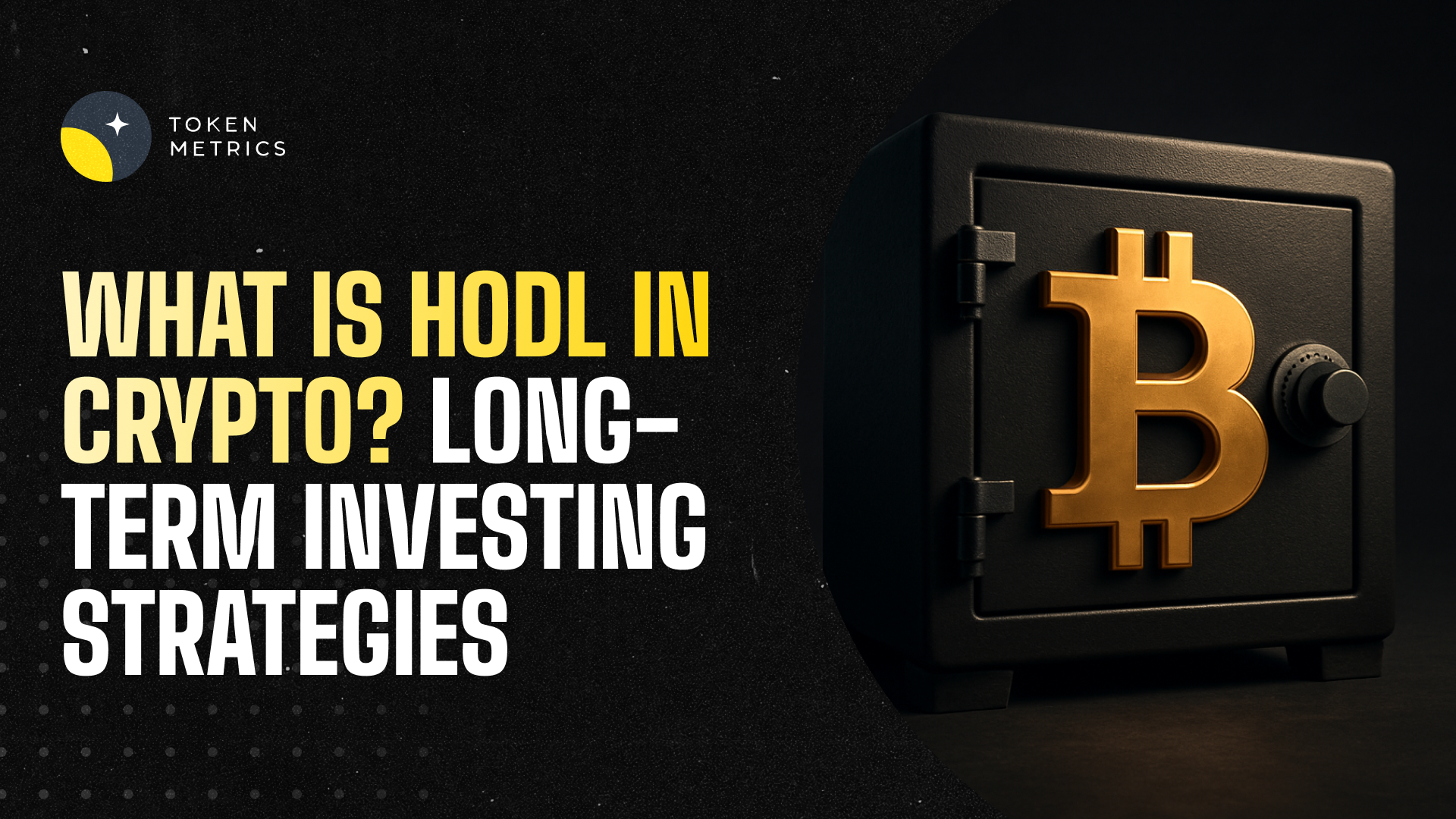
%201.svg)
%201.svg)
If you’ve spent any time in cryptocurrency communities, you’ve likely seen the term HODL. Originally a misspelling of “hold” on an online Bitcoin forum in 2013, HODL has become much more than a typo—it’s now a core investment philosophy for crypto enthusiasts worldwide.
In 2025, HODLing remains one of the most effective long-term strategies for building wealth in cryptocurrency. By holding onto fundamentally strong assets through market volatility, investors can capture long-term gains while avoiding emotional, short-term trading mistakes. This article explores what HODLing means, why it works, the best assets to HODL, and how platforms like Token Metrics can help optimize your strategy.
HODL means buying and holding cryptocurrency for an extended period, regardless of short-term price fluctuations. Unlike traders who attempt to time the market, HODLers adopt a long-term mindset, trusting that the value of quality assets will increase over time.
This strategy is rooted in the belief that blockchain technology and digital assets are here to stay, and that short-term market noise shouldn’t derail long-term conviction.
Crypto markets are notoriously volatile, with sudden price swings that can lead to emotional decision-making. HODLing combats this by:
By committing to HODLing, investors can overcome emotional biases and stay focused on their long-term goals.
While any coin can be HODLed, the best long-term candidates are projects with strong fundamentals, proven track records, and growing ecosystems:

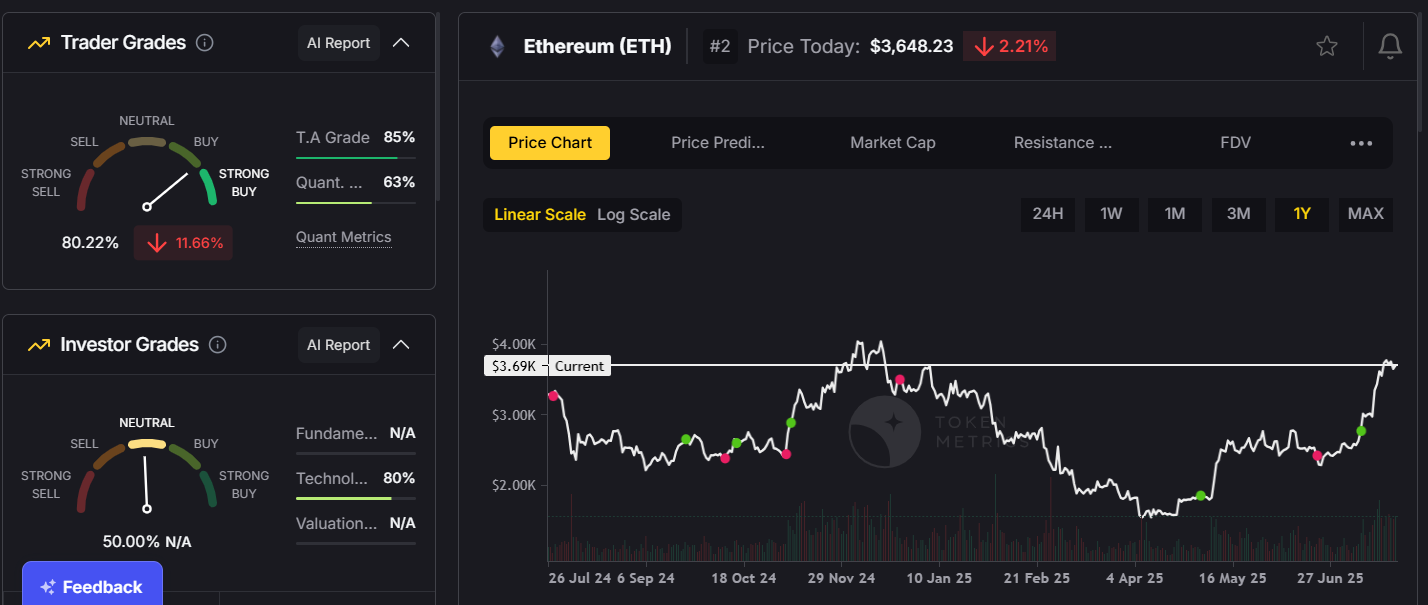
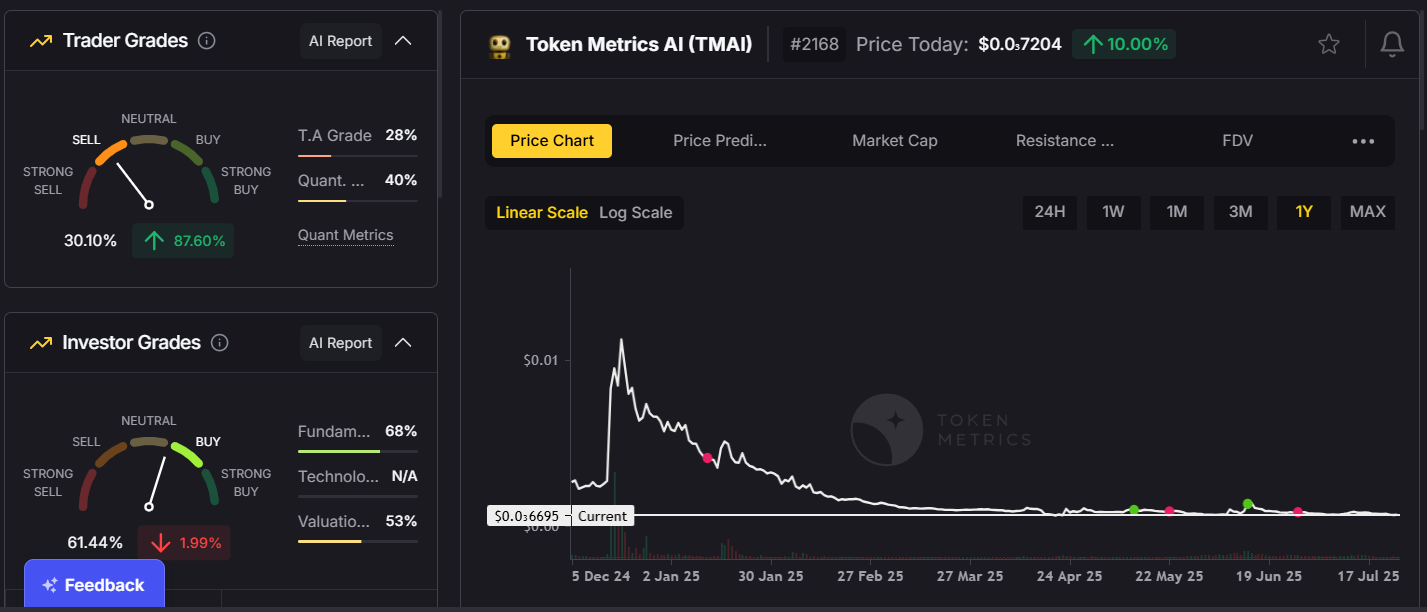
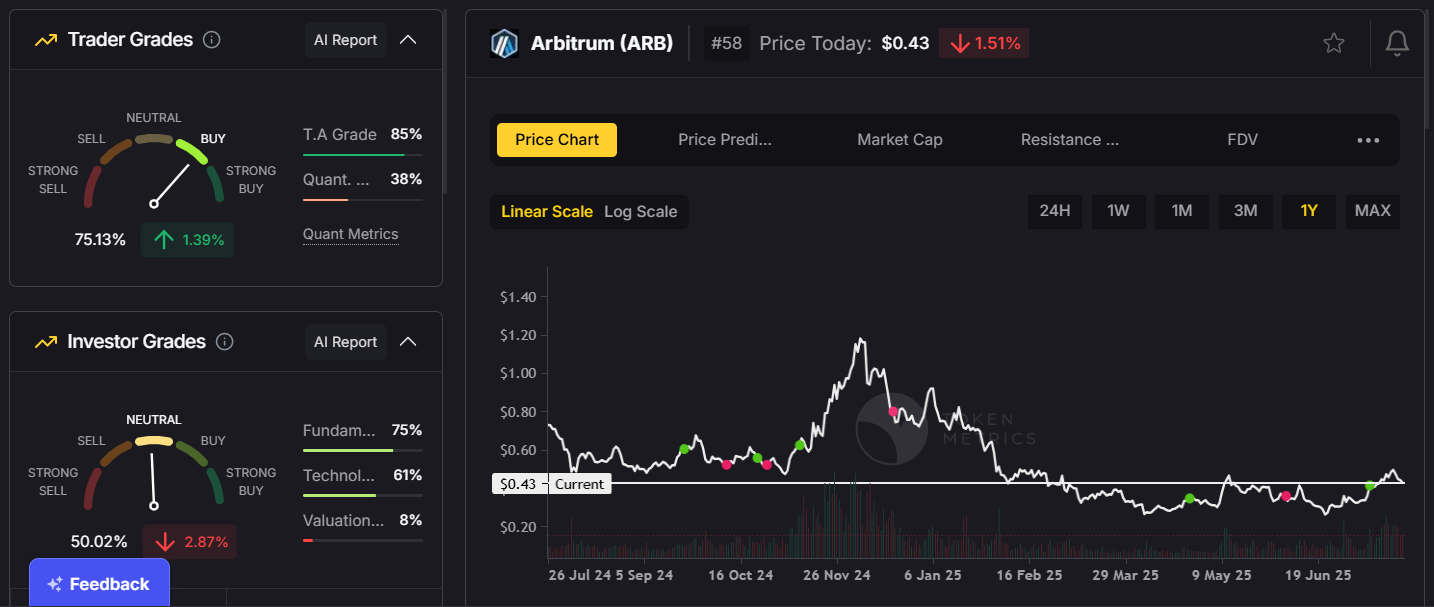
These coins offer long-term growth potential, making them excellent candidates for a HODL strategy.
While active trading can generate quick profits, it also comes with higher risks and costs. Here’s how HODLing compares:
Platforms like Token Metrics can complement both approaches by providing trading signals and long-term portfolio analytics, helping you decide when (and if) you should adjust your positions.
While HODLing is effective, it’s not without challenges:
To mitigate these risks, rely on data-driven tools like Token Metrics to ensure you’re holding the right mix of assets.
Token Metrics is a powerful platform for long-term crypto investors, providing:
By leveraging AI analytics, Token Metrics makes HODLing smarter, ensuring you’re invested in assets with strong fundamentals and growth potential.
HODLing isn’t just a meme—it’s a time-tested strategy for building wealth in crypto. By holding onto fundamentally strong assets, you can capture long-term growth while avoiding the emotional traps of active trading.
In 2025, pairing HODLing with AI-powered insights from Token Metrics gives you an edge—helping you select the right assets, manage risk, and stay committed to your investment plan. Whether you’re a beginner or a seasoned investor, HODLing remains one of the simplest and most effective ways to build wealth in the dynamic world of cryptocurrency.


 Create Your Free Account
Create Your Free Account9450 SW Gemini Dr
PMB 59348
Beaverton, Oregon 97008-7105 US
.svg)




.png)
Token Metrics Media LLC is a regular publication of information, analysis, and commentary focused especially on blockchain technology and business, cryptocurrency, blockchain-based tokens, market trends, and trading strategies.
Token Metrics Media LLC does not provide individually tailored investment advice and does not take a subscriber’s or anyone’s personal circumstances into consideration when discussing investments; nor is Token Metrics Advisers LLC registered as an investment adviser or broker-dealer in any jurisdiction.
Information contained herein is not an offer or solicitation to buy, hold, or sell any security. The Token Metrics team has advised and invested in many blockchain companies. A complete list of their advisory roles and current holdings can be viewed here: https://tokenmetrics.com/disclosures.html/
Token Metrics Media LLC relies on information from various sources believed to be reliable, including clients and third parties, but cannot guarantee the accuracy and completeness of that information. Additionally, Token Metrics Media LLC does not provide tax advice, and investors are encouraged to consult with their personal tax advisors.
All investing involves risk, including the possible loss of money you invest, and past performance does not guarantee future performance. Ratings and price predictions are provided for informational and illustrative purposes, and may not reflect actual future performance.

